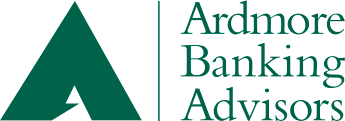
Crafting and Implementing an Effective Loan Review Function
Brought to you by Ardmore Banking Advisors

Performing the loan or credit review function is a regulatory requirement for banks of all sizes and a key credit risk management practice.
Loan review not only helps banks assess emerging risk in their portfolios, but can also protect the institution by identifying loans with potential risk rating downgrades before regulators do. Sometimes called the last or “third line of defense,” an effective loan review function includes a partnership between the loan review staff and the lenders and credit teams that make up the first and second lines of defense to ensure the ongoing constructive monitoring of the bank’s credit quality.
Bank boards have several options when choosing how to implement the commercial credit/loan review function. This includes outsourcing the function to an expert third party loan review service provider, building out their own loan review department internally staffed or blending the two approaches for a hybrid, co-sourced arrangement. Each model has elements and considerations that executives should explore before making final decisions, including the cost to the bank, regulatory expectations, overhead, internal staffing issues and quality of work. Some bank executives are also sensitive to perceptions that institutions above a certain size should internalize the loan review function.
According to high-level members of bank regulatory agencies we have talked with, there is no regulatory expectation for a bank’s loan review model based on the bank’s asset size and no expectation of rotating outsourced loan review providers. The factors most important to the regulators are independence from the internal lending and approving function, the expertise of the loan review analysts, the supportability of loan review’s conclusions and the quality of the entire process. The bank and its board has great freedom to shape the department and its scope to accomplish these objectives.
Outsourced Loan Review
The outsourced loan review model has a number of advantages over internal models. It is almost always the most cost-effective approach. A competent outsourced provider can typically review borrowers in the portfolio more quickly than internal staff, due to their use of best practices and concise analytical approach. Third-party experts usually have deep expertise in a wider range of credit specialty areas, such as commercial real estate segments, agriculture, commercial and industrial, leveraged lending or leasing. An outsourced provider with a broad view of the industry and into similar institutions’ portfolios can add valuable perspective, such as best practices, regulatory intelligence and general peer information. Additionally, the tight labor market has underlined the difficulty of attracting and maintaining staff; loan review departments have had significant issues finding and keeping people. Outsourcing avoids that issue completely, leaving the efforts of hiring, training and retaining competent staff to the provider.
Internal Loan Review
Setting up and maintaining an internal loan review department can help executives build stronger team interaction and relationships within the bank. Internal staff can attend meetings like loan committees and special assets to better understand the bank’s risk appetite. Continuously monitoring the lending portfolio internally can enable the bank to more easily detect shifts in underwriting quality or patterns of emerging risk. A loan review department manager with effective internal staffing can build relationships and set expectations for resolving conflicts. In most cases, the most efficient and effective internal loan review departments use specially developed loan review automation software to enable better staff management, perform more efficient exams and provide consistent results. The competition for seasoned loan review staff can also make effective internal staffing difficult.
Hybrid Loan Review
Using a “hybrid” loan review model where internal staff works with external third-party loan review experts can offer some of the best of both models. Hybrid models can have various configurations: the third party can function like an extension of the internal staff in an arrangement sometimes called “co-sourcing,” or can work independently, reporting to the outsourced provider’s management when working on specific segments of the portfolio. These segments could be the larger or smaller borrower relationships, special problem assets or borrowers in specialized industries or loan types.
The advantages of this model include being able to quickly scale up or down in department size and scope while gaining the benefit of external knowledge from the third-party provider. The hybrid approach works best when all exam work – internal and external – is performed on automated loan review software. Software ensures that the results and findings of the exams are reasonably consistent in nature and the work product and other reports are comprehensive, regardless of whether internal or external resources do the analysis.
Bank boards should leverage loan review resources constructively, no matter what model they choose, being mindful of pitfalls and expense along the way. An effective loan review program protects the bank’s safety and soundness, its customers and shareholders – as well as the board, no matter what model they used.


